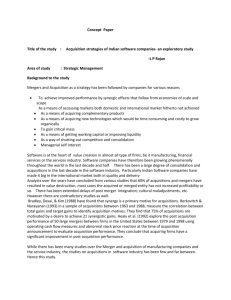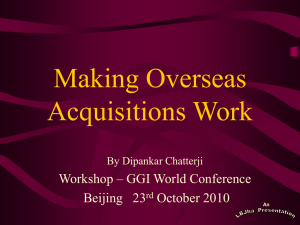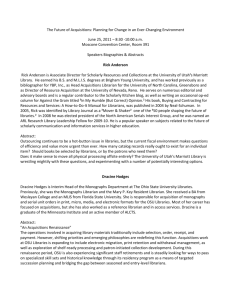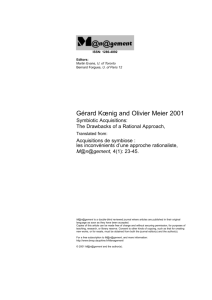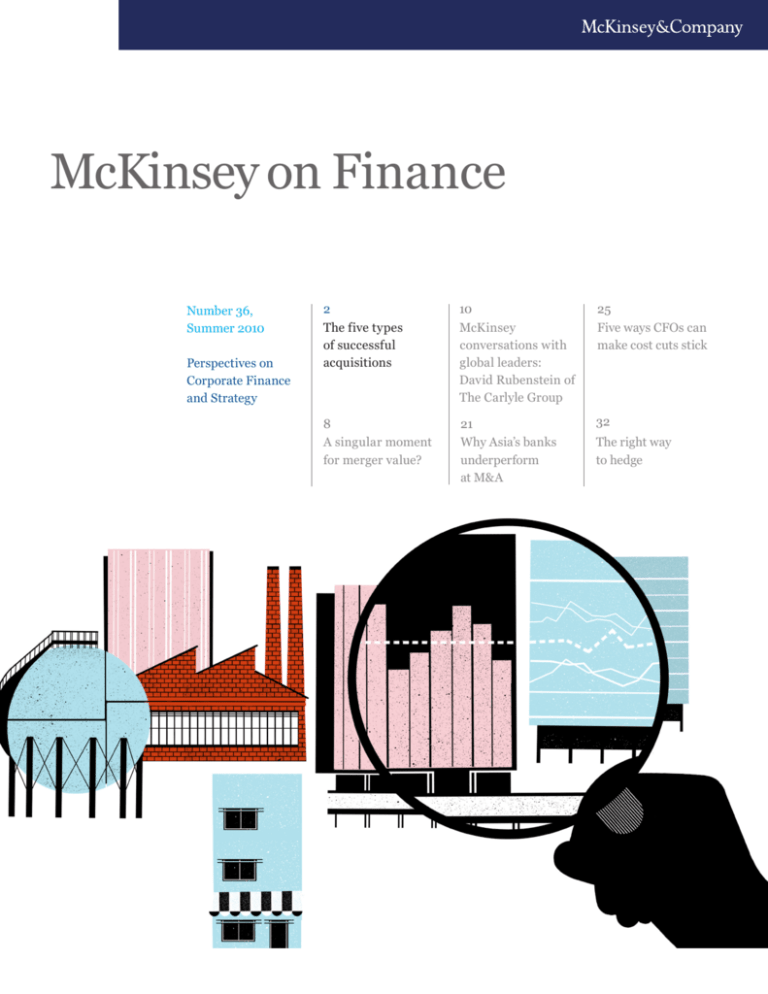
McKinsey on Finance
Number 36,
Summer 2010
Perspectives on
Corporate Finance
and Strategy
2
The five types
of successful
acquisitions
10
McKinsey
conversations with
global leaders:
David Rubenstein of
The Carlyle Group
25
Five ways CFOs can
make cost cuts stick
8
A singular moment
for merger value?
21
Why Asia’s banks
underperform
at M&A
32
The right way
to hedge
2
The five types of successful
acquisitions
Companies advance myriad strategies for creating value with acquisitions—but only
a handful are likely to do so.
Marc Goedhart,
Tim Koller,
and David Wessels
There is no magic formula to make acquisitions
even be the real one: companies typically talk up
successful. Like any other business process, they
all kinds of strategic benefits from acquisitions that
are not inherently good or bad, just as marketing
are really entirely about cost cutting. In the
and R&D aren’t. Each deal must have its own
absence of empirical research, our suggestions for
strategic logic. In our experience, acquirers in the
strategies that create value reflect our acquisitions
most successful deals have specific, well-
work with companies.
articulated value creation ideas going in. For less
successful deals, the strategic rationales—such as
In our experience, the strategic rationale for an
pursuing international scale, filling portfolio gaps,
acquisition that creates value typically conforms to
or building a third leg of the portfolio—tend to be
at least one of the following five archetypes:
vague.
improving the performance of the target company,
removing excess capacity from an industry,
Empirical analysis of specific acquisition strategies
creating market access for products, acquiring
offers limited insight, largely because of the wide
skills or technologies more quickly or at lower cost
variety of types and sizes of acquisitions and the
than they could be built in-house, and picking
lack of an objective way to classify them by
winners early and helping them develop their
strategy. What’s more, the stated strategy may not
businesses. If an acquisition does not fit one or
3
more of these archetypes, it’s unlikely to create
of a high-margin, high-ROIC company. Consider a
value. Executives, of course, often justify
target company with a 6 percent operating-profit
acquisitions by choosing from a much broader
margin. Reducing costs by three percentage points,
menu of strategies, including roll-ups,
to 91 percent of revenues, from 94 percent,
consolidating to improve competitive behavior,
increases the margin to 9 percent and could lead to
transformational mergers, and buying cheap.
a 50 percent increase in the company’s value. In
While these strategies can create value, we find
contrast, if the operating-profit margin of a
that they seldom do. Value-minded executives
company is 30 percent, increasing its value by
should view them with a gimlet eye.
50 percent requires increasing the margin to
45 percent. Costs would need to decline from
Five archetypes
70 percent of revenues to 55 percent, a 21 percent
An acquisition’s strategic rationale should be a
reduction in the cost base. That might not be
specific articulation of one of these archetypes,
reasonable to expect.
not a vague concept like growth or strategic
positioning, which may be important but must be
Consolidate to remove excess capacity from
translated into something more tangible.
industry
Furthermore, even if your acquisition is based on
As industries mature, they typically develop excess
one of the archetypes below, it won’t create value
capacity. In chemicals, for example, companies are
if you overpay.
constantly looking for ways to get more production
Improve the target company’s performance
to enter the industry. For example, Saudi Basic
Improving the performance of the target company
Industries Corporation (SABIC), which began
is one of the most common value-creating
production in the mid-1980s, grew from 6.3 million
acquisition strategies. Put simply, you buy a
metric tons of value-added commodities—such as
company and radically reduce costs to improve
chemicals, polymers, and fertilizers—in 1985 to
margins and cash flows. In some cases, the acquirer
56 million tons in 2008. Now one of the world’s
may also take steps to accelerate revenue growth.
largest petrochemicals concerns, SABIC expects
Pursuing this strategy is what the best private-
production to reach 135 million tons by 2020.
out of their plants, while new competitors continue
continued growth, estimating its annual
equity firms do. Among successful private-equity
acquisitions in which a target company was
The combination of higher production from
bought, improved, and sold, with no additional
existing capacity and new capacity from recent
acquisitions along the way, operating-profit
entrants often generates more supply than demand.
margins increased by an average of about
It is in no individual competitor’s interest to shut a
2.5 percentage points more than those at peer
plant, however. Companies often find it easier to
companies during the same period. This means
shut plants across the larger combined entity
that many of the transactions increased
resulting from an acquisition than to shut their
operating-profit margins even more.
least productive plants without one and end up
with a smaller company.
Keep in mind that it is easier to improve the
performance of a company with low margins and
Reducing excess in an industry can also extend to
low returns on invested capital (ROIC) than that
less tangible forms of capacity. Consolidation in
4
McKinsey on Finance Number 36, Summer 2010
the pharmaceutical industry, for example, has
sales in some emerging markets, Gillette in others.
significantly reduced the capacity of the sales force
Working together, they introduced their products
as the product portfolios of merged companies
into new markets much more quickly.
change and they rethink how to interact with
doctors. Pharmaceutical companies have also
Get skills or technologies faster or at lower cost
significantly reduced their R&D capacity as they
than they can be built
found more productive ways to conduct research
Cisco Systems has used acquisitions to close gaps
and pruned their portfolios of development
in its technologies, allowing it to assemble a broad
projects.
line of networking products and to grow very
While there is substantial value to be created from
into the key player in Internet equipment. From
removing excess capacity, as in most M&A activity
1993 to 2001, Cisco acquired 71 companies, at an
the bulk of the value often accrues to the seller’s
average price of approximately $350 million.
quickly from a company with a single product line
shareholders, not the buyer’s.
Cisco’s sales increased from $650 million in 1993
to $22 billion in 2001, with nearly 40 percent
Accelerate market access for the target’s (or
of its 2001 revenue coming directly from these
buyer’s) products
acquisitions. By 2009, Cisco had more than
Often, relatively small companies with innovative
$36 billion in revenues and a market cap of
products have difficulty reaching the entire
approximately $150 billion.
potential market for their products. Small
pharmaceutical companies, for example, typically
Pick winners early and help them develop their
lack the large sales forces required to cultivate
businesses
relationships with the many doctors they need to
The final winning strategy involves making
promote their products. Bigger pharmaceutical
acquisitions early in the life cycle of a new industry
companies sometimes purchase these smaller
or product line, long before most others recognize
companies and use their own large-scale sales
that it will grow significantly. Johnson & Johnson
forces to accelerate the sales of the smaller
pursued this strategy in its early acquisitions of
companies’ products.
medical-device businesses. When J&J bought
device manufacturer Cordis, in 1996, Cordis had
IBM, for instance, has pursued this strategy in its
$500 million in revenues. By 2007, its revenues
software business. From 2002 to 2009, it acquired
had increased to $3.8 billion, reflecting a 20 percent
70 companies for about $14 billion. By pushing
annual growth rate. J&J purchased orthopedic-
their products through a global sales force, IBM
device manufacturer DePuy in 1998, when DePuy
estimates it increased their revenues by almost
had $900 million in revenues. By 2007, they had
50 percent in the first two years after each
grown to $4.6 billion, also at an annual growth
acquisition and an average of more than 10 percent
rate of 20 percent.
in the next three years.
This acquisition strategy requires a disciplined
In some cases, the target can also help accelerate
approach by management in three dimensions.
the acquirer’s revenue growth. In Procter &
First, you must be willing to make investments
Gamble’s acquisition of Gillette, the combined
early, long before your competitors and the market
company benefited because P&G had stronger
see the industry’s or company’s potential. Second,
The five types of successful acquisitions
5
you need to make multiple bets and to expect that
higher revenues than individual businesses can.
some will fail. Third, you need the skills and
Service Corporation’s funeral homes in a given city
patience to nurture the acquired businesses.
can share vehicles, purchasing, and back-office
Harder strategies
advertising across a city to reduce costs and raise
Beyond the five main acquisition strategies we’ve
revenues.
operations, for example. They can also coordinate
explored, a handful of others can create value,
though in our experience they do so relatively
Size per se is not what creates a successful roll-up;
rarely.
what matters is the right kind of size. For Service
Roll-up strategy
have been more important than many branches
Corporation, multiple locations in individual cities
Roll-up strategies consolidate highly fragmented
spread over many cities, because the cost savings
markets where the current competitors are too
(such as sharing vehicles) can be realized only if
small to achieve scale economies. Beginning in the
the branches are near one another. Roll-up
1960s, Service Corporation International, for
strategies are hard to disguise, so they invite
instance, grew from a single funeral home in
copycats. As others tried to imitate Service
Houston to more than 1,400 funeral homes and
Corporation’s strategy, prices for some funeral
cemeteries in 2008. Similarly, Clear Channel
homes were eventually bid up to levels that made
Communications rolled up the US market for radio
additional acquisitions uneconomic.
stations, eventually owning more than 900.
Consolidate to improve competitive behavior
This strategy works when businesses as a group
Many executives in highly competitive industries
can realize substantial cost savings or achieve
hope consolidation will lead competitors to focus
6
McKinsey on Finance Number 36, Summer 2010
less on price competition, thereby improving the
business in 1997. Organizational changes included
ROIC of the industry. The evidence shows, however,
structuring R&D worldwide by therapeutic rather
that unless it consolidates to just three or four
than geographic area, enabling Novartis to build a
companies and can keep out new entrants, pricing
world-leading oncology franchise.
behavior doesn’t change: smaller businesses or new
entrants often have an incentive to gain share
Across all departments and management layers,
through lower prices. So in an industry with, say,
Novartis created a strong performance-oriented
ten companies, lots of deals must be done before
culture supported by shifting from a seniority- to a
the basis of competition changes.
performance-based compensation system for
managers.
Enter into a transformational merger
A commonly mentioned reason for an acquisition
Buy cheap
or merger is the desire to transform one or both
The final way to create value from an acquisition is
companies. Transformational mergers are rare,
to buy cheap—in other words, at a price below a
however, because the circumstances have to be just
company’s intrinsic value. In our experience,
right, and the management team needs to execute
however, such opportunities are rare and relatively
the strategy well.
small. Nonetheless, though market values revert to
intrinsic values over longer periods, there can be
Transformational mergers can best be described by
brief moments when the two fall out of alignment.
example. One of the world’s leading
Markets, for example, sometimes overreact to
pharmaceutical companies, Switzerland’s Novartis,
negative news, such as a criminal investigation of
was formed in 1996 by the $30 billion merger of
an executive or the failure of a single product in a
Ciba-Geigy and Sandoz. But this merger was much
portfolio with many strong ones.
more than a simple combination of businesses:
under the leadership of the new CEO, Daniel
Such moments are less rare in cyclical industries,
Vasella, Ciba-Geigy and Sandoz were transformed
where assets are often undervalued at the bottom
into an entirely new company. Using the merger as
of a cycle. Comparing actual market valuations
a catalyst for change, Vasella and his management
with intrinsic values based on a “perfect foresight”
team not only captured $1.4 billion in cost
model, we found that companies in cyclical
synergies but also redefined the company’s
industries could more than double their
mission, strategy, portfolio, and organization, as
shareholder returns (relative to actual returns) if
well as all key processes, from research to sales. In
they acquired assets at the bottom of a cycle and
every area, there was no automatic choice for either
sold at the top.
the Ciba or the Sandoz way of doing things; instead,
the organization made a systematic effort to find
the best way.
While markets do throw up occasional
opportunities for companies to buy targets at levels
below their intrinsic value, we haven’t seen many
Novartis shifted its strategic focus to innovation in
cases. To gain control of a target, acquirers must
its life sciences business (pharmaceuticals,
pay its shareholders a premium over the current
nutrition, and products for agriculture) and spun
market value. Although premiums can vary widely,
off the $7 billion Ciba Specialty Chemicals
the average ones for corporate control have been
The five types of successful acquisitions
7
fairly stable: almost 30 percent of the
collect because publicly available data are scarce.
preannouncement price of the target’s equity. For
Private acquisitions often stem from the seller’s
targets pursued by multiple acquirers, the
desire to get out rather than the buyer’s desire
premium rises dramatically, creating the so-called
for a purchase.
winner’s curse. If several companies evaluate a
given target and all identify roughly the same
potential synergies, the pursuer that overestimates
them most will offer the highest price. Since it is
By focusing on the types of acquisition strategies
based on an overestimation of the value to be
that have created value for acquirers in the past,
created, the winner pays too much—and is
managers can make it more likely that their
ultimately a loser.
acquisitions will create value for their shareholders.
Since market values can sometimes deviate from
intrinsic ones, management must also beware the
1Viral V. Acharya, Moritz Hahn, and Conor Kehoe, “Corporate
possibility that markets may be overvaluing a
governance and value creation: Evidence from private equity,”
Social Science Research Network Working Paper, February 19,
2010.
2 IBM
investor briefing, May 12, 2010 (www.ibm.com/investor/
events/investor0510/presentation/pres3.pdf).
3Marco de Heer and Timothy M. Koller, “Valuing cyclical
companies,” mckinseyquarterly.com, May 2000.
4Kevin Rock, “Why new issues are underpriced,” Journal of
Financial Economics, 1986, Volume 15, Number 1–2, pp. 187–212.
potential acquisition. Consider the stock market
bubble during the late 1990s. Companies that
merged with or acquired technology, media, or
telecommunications businesses saw their share
prices plummet when the market reverted to
earlier levels. The possibility that a company might
pay too much when the market is inflated deserves
serious consideration, because M&A activity seems
to rise following periods of strong market
performance. If (and when) prices are artificially
high, large improvements are necessary to justify
an acquisition, even when the target can be
purchased at no premium to market value.
Premiums for private deals tend to be smaller,
although comprehensive evidence is difficult to
Marc Goedhart (Marc_Goedhart@McKinsey.com) is a consultant in McKinsey’s Amsterdam office, Tim Koller
(Tim_Koller@McKinsey.com) is a partner in the New York office, and David Wessels, an alumnus of the New York
office, is an adjunct professor of finance at the University of Pennsylvania’s Wharton School. This article is excerpted
from Tim Koller, Marc Goedhart, and David Wessels, Valuation: Measuring and Managing the Value of Companies (fifth
edition, Hoboken, NJ: John Wiley & Sons, August 2010). Tim Koller is also coauthor, with Richard Dobbs and Bill
Huyett, of a forthcoming managers’ guide to value creation, titled Value: The Four Cornerstones of Corporate Finance
(Hoboken, NJ: John Wiley & Sons, October 2010). Copyright © 2010 McKinsey & Company. All rights reserved.



